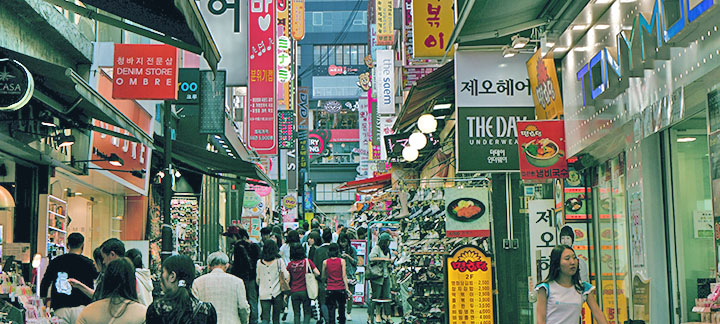

South Korea is one of the world’s strongest economies and an extremely attractive Asian market for wine producers, who are betting on the ever-increasing popularity of this beverage among the country’s middle class.
Trends to take into consideration
In the last years wine managed to establish itself as a top preference in the alcoholic beverage sector, a historic result as wine imports were bigger than spirits imports for the first time ever in 2015. This surge in wine imports represents a continuing trend in South Korea’s growing appreciation for wine. The country’s wine imports have seen a remarkable upward trajectory, ascending from US$260 million in 2019 to US$330 million in 2020, and subsequently surpassing the US$500 million mark in 2021.
In the last couple of years, wine imports started growing significantly, especially in value. According to the Korea Customs Service, South Korea witnessed a notable surge in its wine imports during 2022. The total value of wine imports, classified under HS code 2204, amounted to a substantial US$581.27 million. This marked an increase of close to 4 percent compared to the preceding year. Interestingly, while the overall volume of wine imports experienced a decrease from 76,515 tonnes to 71,020 tonnes, there was a notable uptick in the importation of premium wines.
Koreans perceive wine as a healthier drink than spirits and they also appreciate the more sophisticated allure of wine, especially when paired with various European dishes. Wine is also becoming a very popular drink at weddings, replacing more traditional beverages such as soju.
Another positive aspect is that Korea is home to an ever-increasing number of sommeliers and wine publications, which contribute to the education and diversification of tastes in this field.
On the downside, a factor that stays in the way of an even larger growth for wine is its very high price, despite the elimination of many of the taxes thanks to the KORUS FTA and the Korea-EU FTA. According to a recent survey that analysed prices among major cities around the globe, Seoul had some of the highest prices for imported wine and beer (sometimes up to 2x compared to other large cities).
On-trade vs. off-trade
Korea is atypical compared to other Asian markets, as most of the sales of imported wine can be attributed to off-trade, especially the retail sector, which is valued at around 900 million USD for this category. The price is probably an important factor, as the high-end bars, restaurants and hotels are still restrictive to many Koreans. They prefer to shop wine from the very popular supermarkets that dominate sales in Seoul (Lotte, Costco, E-mart, Homeplus). The same shoppers are expected to drive significant growth in the low to medium priced wine category in the next years.
Speaking of Seoul, even if the capital is the heart of the country’s economy and the focus of the majority of new companies trying to enter the market, some analysts also recommend trying to navigate some of Korea’s other important cities, like Busan. Competition can be lower and the importers less saturated.
Analysing the origin of imports, the Korean wine market has long been dominated by countries like France or Chile but the environment is quickly changing. US wine producers are finding increasing success, thanks in part to the excellent US – Korea relations and the positive perception of US brands by the population. Spain and Australia are also more present, increasing the diversity of wines available. Many of the other well known wine regions are represented in Korea, thanks in part to the well-traveled Koreans who have brought home the passion for a wide range of wines.
When examining the origins of wine imports in 2022, it becomes evident that France was still the leading supplier, exporting wine valued at US$130 million to South Korea. The United States followed closely, with wine exports reaching US$95.8 million. Other notable contributors included Italy with US$71 million, Chile with US$65 million, and Australia with US$29.6 million. Sparkling wine, particularly from France and Italy, also held a prominent position in South Korea’s wine market. French sparkling wine imports stood at US$71.75 million, and Italian sparkling wine imports amounted to US$14.3 million.
Other alcoholic beverages
In 2022, whiskey imports experienced a remarkable upswing as well, surging by over 50 percent when compared to the figures from 2021. Specifically, the total value of imported whiskey, classified under HS code 220830 and including varieties like scotch, bourbon, and rye, reached an impressive US$266.8 million in 2022. This represented a substantial 52 percent increase from the US$175.3 million recorded in the corresponding period of the previous year. Correspondingly, the volume of whiskey imports soared by 72.6 percent, escalating from 15,661 tons to 27,038 tons within the same timeframe.
It’s worth noting that South Korea’s whiskey import figures have experienced fluctuations over the years. For instance, whiskey imports reached a peak of US$270.3 million in 2007 but subsequently followed a downward trajectory, plummeting to US$132.4 million in 2020. However, 2021 marked a resurgence, with a noteworthy 32.4 percent increase in whiskey imports, setting the stage for the impressive growth witnessed in 2022.
Tips for entering the market
Despite all the positive aspects, building a wine brand in Korean is not easy. The companies that are having success have invested a lot, both financially and timewise in their market presence. Most of them have a team in the country or at least visit regularly in order to develop relationships with both the importers/distributors and the consumers. For the majority of the Korean importers, face-to-face meetings or business dinners are a must at least at a certain stage of the talks. Because Korea has such a unique culture, understanding it is vital in order to be able to predict consumer preferences and needs.
Picking the right Korean partner is an extremely important and often complicated process as the ecosystem is constantly changing and importers appear and disappear each year. Prior research of the importer’s past and connections is more than recommended. You can try calling some of the producers from the importer’s portfolio and try to find out more information about their relationship.
Another problem is that many of the serious importers have become quite conservative and take few risks when accepting new wines. They prefer wines that come with recommendations from influential sources, like the top wine magazines.
Once a solid partner is found, he should be able to help you implement marketing strategies, as well as offer market information and help with customs clearance and wine promotion.
Finding wine importers can be done via various strategies. An initial step can be cold contacting via a reliable list in order to get an appointment and later set-up a meeting. Visiting the country’s major expos, like Seoul Food and Hotel or getting in touch with a government or trade agency is also recommended. You can read a very useful guide that will help you approach and deal with wine importers here.
Some of South Korea’s top wine importers and retailers: Vinideus Co Ltd, Wine 2U Korea, Boa Trading, Handok Wine Co, Indulge or Winenara.
For an extended list that includes details about the wine importers and distributors from South Korea you can purchase the up-to-date BestWineImporters database.
Author: Sergiu Briceag





